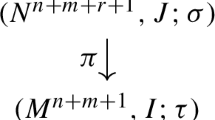Abstract
Each linear program (LP) has an optimal basis. The space of linear programs can be partitioned according to these bases, so called the basis partition. Discovering the structures of this partition is our goal. We represent the space of linear programs as the space of projection matrices, i.e., the Grassmann manifold. A dynamical system on the Grassmann manifold, first presented in Sonnevend et al. (Math Program 52:527–553), is used to characterize the basis partition as follows: From each projection matrix associated with an LP, the dynamical system defines a path and the path leads to an equilibrium projection matrix returning the optimal basis of the LP. We will present some basic properties of equilibrium points of the dynamical system and explicitly describe all eigenvalues and eigenvectors of the linearized dynamical system at equilibrium points. These properties will be used to determine the stability of equilibrium points and to investigate the basis partition. This paper is only a beginning of the research towards our goal.
Similar content being viewed by others
References
Boothby W.M.: An Introduction to Differentiable Manifolds and Riemannian Geometry. Academic Press, London (1975)
Bullo F., Lewis A.D.: Geometric Control of Mechanical Systems. Springer, Heidelberg (2004)
Helmke U., Moore J.B.: Optimization and Dynamical Systems. CCES. Springer, London (1994)
Güler O.: Limiting behavior of weighted central paths in linear programming. Math. Program. 65, 347–363 (1994)
Sonnevend G., Stoer J., Zhao G.: On the complexity of following the central path of linear programs by linear extrapolation II. Math. Program. 52, 527–553 (1991)
Wright S.J.: Primal–Dual Interior-Point Methods. SIAM, Philadenthia (1997)
Ye Y.: Interior Point Algorithms—Theory and Analysis. Wiley, London (1997)
Author information
Authors and Affiliations
Corresponding author
Additional information
Research is supported in part by NUS Academic Research Grant R-146-000-084-112.
The author wishes to thank Josef Stoer for his valuable comments on the paper and to thank Wingkeung To, Jie Wu, Xingwang Xu, Deqi Zhang and Chengbo Zhu for providing consultations on Differential Geometry and Grassmann manifolds and pointing out useful literature. The author is certainly responsible to all faults in the paper.
Rights and permissions
About this article
Cite this article
Zhao, G. Representing the space of linear programs as the Grassmann manifold. Math. Program. 121, 353–386 (2010). https://doi.org/10.1007/s10107-008-0237-6
Received:
Accepted:
Published:
Issue Date:
DOI: https://doi.org/10.1007/s10107-008-0237-6




